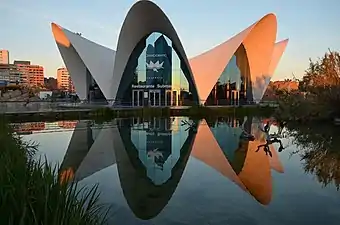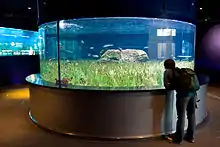| L'Oceanogràfic | |
|---|---|
 Entrance to the marine complex | |
| 39°27′10″N 0°20′53″W / 39.45279°N 0.34812°W | |
| Date opened | 14 February 2003 |
| Location | Valencia, Spain |
| Land area | 110,000 square metres (1,200,000 sq ft)[1] |
| No. of animals | 45,000 |
| No. of species | 500 |
| Volume of largest tank | 7,000,000 litres (1,800,000 US gal) |
| Total volume of tanks | 42,000,000 litres (11,000,000 US gal)[1] |
| Owner | Avanqua Oceanogràfic SL |
| Website | www |
L'Oceanogràfic (Valencian: [loseˌanoˈɣɾafik], Spanish: El Oceanográfico [el oˌθe.anoˈɣɾafiko], 'The Oceanographic') is an oceanarium situated on the dry Turia River bed to the southeast of the city center of Valencia, Spain, where different marine habitats are represented. It was designed by the architect Félix Candela and the structural engineers Alberto Domingo and Carlos Lázaro. It is integrated inside the cultural complex known as the Ciutat de les Arts i de les Ciències (City of Arts and Sciences). It was opened on 14 February 2003.
General information
_01.jpg.webp)
The Oceanographic is the largest complex of its type in Europe, spanning 110,000 square metres (1,200,000 sq ft) and holding a capacity of 42,000,000 litres (11,000,000 US gal) of water,[1] including a 26,000,000-litre (6,900,000 US gal) dolphinarium and a 7,000,000-litre (1,800,000 US gal) ocean tank with sharks, rays and other fish.[1] It is home to 45,000 animals from 500 different species—including sharks, penguins, dolphins, sea lions, walruses, beluga whales, birds, reptiles and invertebrate—all inhabiting nine two-tiered underwater towers representing the Earth's major ecosystems. The aquariums utilize sea water pumped from the La Malva-Rosa beach.
The park is divided into ten areas: the marine areas are arranged into Mediterranean habitats, the Arctic oceans, islands, the tropics, the temperate seas and the Red Sea. The park also includes a dolphinarium, an area of mangrove swamps and marshland, and a garden with more than 80 different species of plants.
Design and operation

The steel-fiber reinforced concrete thin-shell structure was designed by renown architect Félix Candela, at age 87 in 1997, and structural engineers Alberto Domingo and Carlos Lázaro.[2][3] The distinctive hyperbolic parabola (hypars) shape of the roof is reminiscent of the Los Manantiales Restaurant in Mexico City, which Candela designed in 1958.[4]
The Oceanographic is currently operated in partnership with the Vancouver Aquarium Marine Science Centre in Vancouver, British Columbia, Canada.
Transportation
L'Oceanogràfic can be reached via Metro, disembark at Alameda Station or through bus number 15, 25 and 95. It is also served by Metrovalencia Line 10 tram from its Oceanogràfic stop.
Gallery
- Tour of L'Oceanogràfic in Valencia
 Sand tiger sharks in the ocean tank
Sand tiger sharks in the ocean tank Mediterranean seagrass aquarium
Mediterranean seagrass aquarium Beluga whale in the arctic tank
Beluga whale in the arctic tank






See also
References
- 1 2 3 4 L'Oceanogràfic: Know. Retrieved 24 December 2013
- ↑ "L'Oceanogràfic - Restaurant". structurae.net. Retrieved 10 June 2020.
- ↑ "L'Oceanogràfic - Access Building". structurae.net. Retrieved 10 June 2020.
- ↑ Miller, Michelle (April 14, 2014). "AD Classics: Los Manantiales / Felix Candela". archdaily.com. Retrieved 10 June 2020.
External links
- Official website

- Aquarium Oceanografic at the Valencia Tourism Board
- AVANQUA OCEANOGRAFIC SL at Dun & Bradstreet